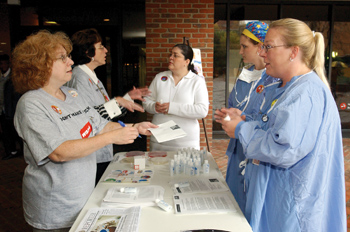
From left, Katie Wilkerson, R.N., an infection control practitioner, Cindy Irwin, R.N., a clinical risk manager, Maria Fonseca-Kheshtl with utilization management, Tracey Bunch, an anesthesia technician, and Kelly Cole, R.N., talk about washing up during Hand Hygiene Awareness Day on Wednesday. Members of the VUMC Hand Hygiene Task Force visited patient care units to hand out cookies and spread the message that improved adherence to basic hand hygiene presents the biggest opportunity to reduce infections acquired in hospitals. The effort includes new annual training requirements, more alcohol gel dispensers for hand washing, ongoing monitoring of hand washing practices and other changes. Elements of the hand hygiene campaign have been under way since this summer at the Monroe Carell Jr. Children's Hospital at Vanderbilt.
photo by Dana Johnson
Study sheds new ‘light’ on nerve stimulation
Biomedical engineers and physicians at Vanderbilt University are studying a method that uses laser light, rather than electricity, to stimulate and control nerve cells.
The researchers have discovered that low-intensity infrared laser light can spark specific nerves to life, exciting a leg or even individual toes without actually touching the nerve cells.
“This technique brings nerve stimulation out of the dark ages,” says Anita Mahadevan-Jansen, Ph.D., assistant professor of Biomedical Engineering and Neurological Surgery. “Much work is going on around the world trying to make electric nerve stimulation better, but the technique is inherently limited. Using lasers instead, we can simultaneously excite and record the responses of nerve fibers with much greater precision, accuracy and effectiveness.”
The method was developed by Mahadevan-Jansen, her husband Duco Jansen, Ph.D., associate professor of Biomedical Engineering and Neurological Surgery; Peter Konrad, M.D., and Chris Kao, M.D., both assistant professors of Neurological Surgery; and biomedical engineering doctoral student Jonathon Wells.
In an experiment with rats, the scientists used a laser to stimulate the sciatic nerve and to control muscles in the animals’ hind legs and individual toes, demonstrating accuracy beyond the limitations of electrical stimulation. Immediately following the experiment the rats regained full use of their legs with no signs of weakness or damage.
Konrad, who is also director of the Vanderbilt Functional Neurosurgery program, points out that neurostimulation is ideally done cell by cell. “The problem with the conventional electrical method is that we have a large zone around our target neuron that also is affected, simply because of the way electricity travels throughout the tissue. Using light to stimulate neurons, we can pick off a single neuron without affecting the other neurons around it.”
In a matter of months, Kao says, a machine could be created that helps guide neurosurgeons to the target nerves during rhizotomy, a procedure that frees someone from a spastic or seemingly frozen muscle, as when someone's head is stuck in a tortuous position. Currently, once the proper neural region is selected, surgeons pinpoint the individual nerves by a process of elimination, striking nerves with an electric probe while the patient is awake to ensure that the right nerve has been located.
But electrical probes create a halo of electrical activity in surrounding neurons, creating a "blind spot" and other inaccurate data in the recording and analysis of the procedure, making it tedious and difficult to locate the exact nerve.
Optics, on the other hand, can deliver laser precision by stimulating only the nerve cell of interest.
The idea of optical stimulation started as the scientists questioned whether they could accurately detect the movement through the brain of an electrical impulse from a nerve cell. Konrad suggested using light to trace the activity, and Mahadevan-Jansen thought of using laser light to stimulate nerves and to actually generate this activity.
Vanderbilt's W.M. Keck Foundation Free Electron Laser Center was the perfect facility to give it a try. The FEL, funded by the Department of Defense, one of only a handful in the world and the only one equipped to perform medical experimental research, was used to see if the idea worked and to determine the optimal settings for the laser.
Now that the research team has shown that the process works and that it is safe, they are turning their attention to studying the exact mechanisms behind the stimulation effects. The most likely candidates, Jansen and Wells say, include a photothermal or mechanical effect, or perhaps a combination of the two.
The scientists are beginning experiments in the central nervous system.
Mahadevan-Jansen says that the technique, which is pending patent approval, is not the only novel aspect of this work. "This research results from the marriage of biomedical engineering, optical science and neurological research," Mahadevan-Jansen says. "Some programs are working on optics, and some are working on neurological stimulation, but nobody has put them together."
Imagining future applications, Konrad says he can envision an array of fiber optic threads that runs directly from the brain or spinal cord to a prosthetic arm or leg, creating a true man-machine interface.













